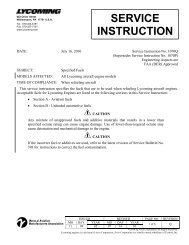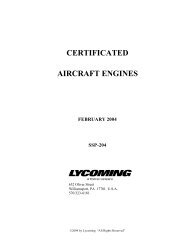You also want an ePaper? Increase the reach of your titles
YUMPU automatically turns print PDFs into web optimized ePapers that Google loves.
Comparing various parts and accessories used in engine models<br />
which some individuals have considered to be much the same,<br />
illustrates the differences. Although some <strong>Lycoming</strong> models<br />
are closely related, this cannot be assumed. A review of the<br />
engineering parts list for each engine model by a knowledgeable<br />
individual is the only sure way of establishing similarities and<br />
differences. Those who may have been taken in by the myth that<br />
all <strong>Lycoming</strong> engines of a particular displacement are very much<br />
the same are now armed with a better knowledge.<br />
There are many who look for an aircraft engine on the open<br />
market. While there is nothing wrong with this approach to<br />
acquiring a needed power plant, it sometimes results in an<br />
unfortunate choice. Perhaps a little information on the possible<br />
pitfalls may help to reduce the number of bad choices.<br />
Individuals working on home-built aircraft may be particularly<br />
susceptible to this type of error. At <strong>Lycoming</strong>, there have been<br />
many calls from people who grabbed an engine that seemed to<br />
be an exceptionally good deal — only to find that this “engine of<br />
their dreams” would not fit into the aircraft they are building.<br />
Consider the circumstances which lead to these problems. The<br />
person looking for an engine is usually building an aircraft from<br />
his own plans or from a kit supplied by a kit manufacturer.<br />
As the airframe begins to take shape, obtaining a suitable engine<br />
may be reason for some concern and anxiety. When a <strong>Lycoming</strong><br />
0-320, 0-360 or other engine with appropriate horsepower rating<br />
is found, there is a temptation to buy now and ask questions later.<br />
This could be a serious mistake.<br />
The article “Low-time Engine May Not Mean Quality and<br />
Value” that appears next in this booklet explains that old engines<br />
with low time are frequently affected by internal rust and corrosion.<br />
Any engine that is not used frequently should be preserved.<br />
The condition of the engine is just one of the items to be considered<br />
when acquiring a power plant in the resale market.<br />
Other mistakes often involve the engine model. Unfortunately,<br />
there are those who believe that all <strong>Lycoming</strong> 0-320 engine<br />
models are alike, and that all <strong>Lycoming</strong> O-360 engine models<br />
are also very similar. The <strong>Lycoming</strong>-certified aircraft engine<br />
list shows 58 O-320 models and 51 0-360 models. While these<br />
engines may be similar in many respects, it is the differences that<br />
are likely to cause installation problems. These differences should<br />
be well understood before an engine is purchased.<br />
What are the differences that may cause installation problems?<br />
The engine-mounts should be considered. Older engine models<br />
were built with conical mounts that make installation somewhat<br />
easier, but which do not dampen engine vibration as well. With<br />
very few exceptions, engines certified during the l970s and 1980s<br />
have dynafocal mounts.<br />
Although the type of engine mount is not likely to be a<br />
serious problem, the shape of the sump, the location of the<br />
carburetor or an engine-mounted oil filter may result in airframe<br />
interference which makes installation of a particular engine<br />
model difficult or impossible. Some aircraft, for example, do not<br />
have enough space between the engine and the fire-wall for an<br />
engine-mounted oil filter. In the case of an engine with a<br />
single-unit dual magneto, there is nothing that can be done since<br />
the filter is a required part of the engine design. All <strong>Lycoming</strong><br />
engines with two individual magnetos can be configured to<br />
operate without an oil filter. Should an oil filter and the space<br />
needed to remove it be the only problem in adapting this type of<br />
engine to an airframe, the filter and adapter can be removed and<br />
an oil pressure screen housing can be installed instead. Should this<br />
step be necessary, the recommended oil change interval is reduced<br />
to 25 hours. A second option would involve removing the filter<br />
from its standard location and mounting it remotely.<br />
Engine to firewall is not the only area where space may be limited.<br />
The sump is often tailored in size and shape to meet the requirements<br />
for a particular airframe. For that reason, the home-builder<br />
may find that some engine models will not fit the plane being built<br />
because of interference. As if this were not enough to be concerned<br />
about, the carburetor or fuel injector location must also be<br />
considered. These fuel-metering devices are frequently mounted<br />
under the engine in an updraft configuration, but there are also<br />
front- and rear-mounted configurations. Some engine models are<br />
equipped with horizontal carburetors. All of these variations in<br />
model, may have an effect on engine/airframe fit.<br />
Another error in choice which occurs all too frequently is the<br />
purchase of an engine originally designed for a high-wing aircraft<br />
when the builder has a low-wing design under construction. The<br />
low wing needs a fuel pump, but the high wing usually delivers<br />
fuel to the carburetor by gravity. In most cases, a fuel pump cannot<br />
be added to the engine because the drive mechanism was not built<br />
in during engine manufacture, and the accessory housing was not<br />
machined to allow mounting of a fuel pump.<br />
As a result of contacts with individuals who have made engine<br />
purchases for their aircraft, we know that the variations in<br />
engine configuration outlined in this article have resulted in<br />
problems. The purpose of bringing these issues to the attention<br />
of <strong>Flyer</strong> and Key Reprints readers is to help them avoid<br />
making the same mistakes others have made. If a particular<br />
engine model has been recommended by a kit manufacturer, it<br />
is best to search out that model. Although similar, other engine<br />
models may not meet your needs.<br />
Choosing the right engine is often a difficult decision that<br />
ultimately could affect the success of the home-built aircraft.<br />
Finding a used engine is tricky and, as we have already covered,<br />
the builder has to keep a lot of factors in mind such as size<br />
and configuration.<br />
<strong>Lycoming</strong> recognizes that home-built aircraft builders are<br />
mechanically inclined and technically trained and are always<br />
striving for more options and new technologies. Therefore,<br />
<strong>Lycoming</strong> has recently launched several new product lines that<br />
offer builders the “Power of Choice.”<br />
<strong>Lycoming</strong> works very hard with Experimental Aircraft<br />
Manufacturers to ensure that they have power plants for their<br />
customers. <strong>Lycoming</strong> currently offers fully assembled Certified<br />
L y c o m i n g F l y e r 9







